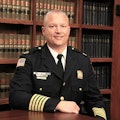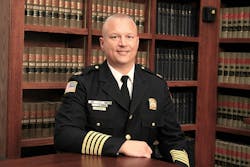Firefighters' Mental Health Is Aided When Departments Plan for Major Incidents
Key Takeaways
- Without preplanning wellness care, fire departments omit an important opportunity to help members’ mental well-being after they respond to an active-shooter or other mass-casualty incident.
- No. 13 of the Firefighter Life Safety Initiatives by the National Fallen Firefighters Foundation can serve as inspiration for a department to expand support in regard to members behavioral health.
- Resiliency training can provide education about resiliency components and awareness regarding resources following a stressful incident to which firefighters and EMS providers respond.
How will your department’s mental wellness program serve members following a major incident? In Highland Park, IL, on July 4, 2022, a rooftop shooter fired more than 80 shots from a rifle into a parade crowd. After the first 30 rounds, the crowd hesitated, believing that it might be fireworks. After a pause, the cadence of shots returned. The crowd, which included on- and off-duty Highland Park Fire Department (HPFD) members and their families, began to see the horrific injuries and present danger. People fled to find a place to hide as the shooter continued. In less than one minute, the shooter killed five immediately; two people died at the hospital, and 48 were injured.
Being the most tragic incident in the city’s history, our first responders were thrust into a horrific circumstance with no notice or expectation. The shooter’s location was unknown, but the shots had stopped. Our members took great risk to begin triage, care and transport. Their immediate actions were lifesaving.
Two hours into the incident, the primary medical response was complete. Enough off-duty members had responded to allow the command staff to relieve most initial responders.
Although there was no pause in the action (the shooter hadn’t been apprehended), member support was needed prior to sending the initial crews home. The local critical incident stress management (CISM) team was called in to defuse crews prior to leaving. The shooter was apprehended several hours later.
Investing in preplanning
Most every department has preplanned responses to varied emergencies, including fires, hazmat, technical rescue, mass casualty, etc. Buildings, businesses and other community assets have been preplanned. Yes, protecting community assets is important. How about the department’s most valuable asset? Does your department preplan wellness care, before and after incidents, for its employees? If you experience The Big One, is your department’s preplan ready to handle the worst tragedy that staff will experience?
Firefighter Life Safety Initiative No. 13 is psychological support. Firefighters and their families must have access to such support and counseling. In reflection, HPFD members realized that the rooftop shooter watched their rigs, which carried members and their families, pass his location before he began to shoot. They easily could have been victims. Firefighters accept the risks that they must take but never assume that their families will be at risk. Caring for members’ families became a vital component of our response.
Like other initiatives and training drills, No. 13 was established following tragic events. It inspired the HPFD to expand support to members in policy, leading to a foundation that was leaned on during the shooting.
In addition, by definition, these incidents affect more than one department. Automatic aid and mutual aid are used for most every response (fires, hazmat, technical rescue, medical, etc.) that challenges in-house resources. Departments set up tiered responses of mutual aid to help. What about mental health for members? Who should you put on your “Box Card?”
With thoughtful interagency planning, departments are prepared to support each other after an incident.
Putting policy into practice
The HPFD participated in resiliency training that was provided by the Illinois Fire Service Institute (IFSI) and further developed policies and standard operating guidelines (SOG) that provide direction.
The IFSI resiliency training provides education about resiliency components and awareness regarding available resources following a stress event.
Department Policy No. 23 for Critical Incident Stress provides a plan for CISM team activation, member care and a list of available resources. Department Policy No. 40 for Fire Department Chaplain sets forth the training, role and identification of a chaplain.
Fortunately, the HPFD didn’t have to use its Standard Operating Guideline A-114: Fire Department Member Death or Serious Injury.
Expanding the approach
The policies and SOGs were a great starting point, given the realization that the July 4 incident would require a more intimate and comprehensive approach.
No different than responding to an incident, a team approach to care for members and their families is vital. Union leadership and management teamed up. The approach enhanced trust, communication and engagement in the process.
Three days after the incident, members were debriefed by a CISM team. Nearby departments provided station coverage, and overtime was offered to any off-duty members who would participate in the debriefing. Most members attended.
The city supported members to anonymously seek mental health care through two separate provider groups that specialize in first responder care. No insurance was collected, and no names were provided to the city, which paid for the sessions.
Follow-up, including pet therapy, gatherings and medals of valor for members who were in the hot zone, continued.
Developing the preplan
The following questions might help to identify challenges in maintaining policy, guidelines and programs:
- Vet resources. When was the last time that peer support, CISM provider, chaplain, etc., were vetted? Was the policy created at the administrative level? Did its development involve members? Who will members trust to help?
- Support command staff/chief officers. Same resources? With the entire membership or a hybrid?
- Chaplaincy program. Does your department have the resources to hire a chaplain to establish relationships and focus on members’ mental health? Can you tap into local clergy members to serve as trained volunteer chaplains who can be present to your membership?
- Facilitate access. Are the resources proactive? Is access enough? Will members call for help? Do they need a nudge? Should an annual check-in be built into NFPA 1582: Standard on Comprehensive Occupational Medical Program for Fire Departments physicals? Is that provider properly trained?
- Support mutual aid. Have you planned to offer help to members of other organizations (automatic aid, mutual aid, hospital staff, dispatch, law enforcement partners, etc.)?
A measured approach
Don’t fall into the trap of being hypercritical following the incident. Yes, firefighters want the response to be perfect, but recognize the size and complexity of the incident. Compare the incident with available resources. Now, did your team do an amazing job? If so, make sure they know that. Don’t forget to recognize heroic efforts.
Think big. Prepare. Preplan. Do it right the first time.
About the Author

Joe Schrage
Joe Schrage is a 29-year veteran of the fire service who currently serves as the fire chief for the Highland Park, IL, Fire Department (HPFD). He began as a chaplain and a paid -on-call firefighter prior to his current 22-year tenure at the HPFD. Schrage serves as a member of the executive boards of the Illinois Fire Chiefs Association and Northern Illinois Public Safety Training Academy and as vice president of Division 3 of the Mutual Aid Box Alarm System. He served as a trustee for the Warrenville, IL, Fire Protection District and as a peer assessor for Center for Public Safety Excellence (CPSE). Schrage received an associate degree in fire science from Southwestern Illinois College, a bachelor’s degree from Loyola University Chicago and a Master of Divinity from University of Saint Mary of the Lake. He completed the Chief Fire Officer program, attained multiple National Fire Academy certifications, and was awarded the Chief Fire Officer designation from the CPSE.
